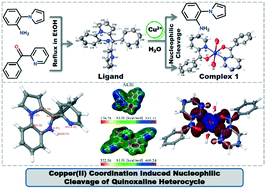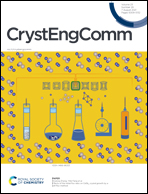Unprecedented copper(ii) coordination induced nucleophilic cleavage of a quinoxaline heterocycle: structural and computational studies†
Abstract
A straightforward catalyst-free synthetic approach has been developed for the synthesis of a quinoxaline derivative, 4-phenyl-4-(pyridin-2-yl)-4,5-dihydropyrrolo[1,2-a]quinoxaline (L), by the reaction of 2-benzoyl pyridine and pyrrole-1-anillin in ethanol. L in the presence of a stoichiometric amount of copper(II) perchlorate becomes decomposed unprecedentedly to produce a copper(II) complex, [CuL′2(H2O)2](ClO4)2 (1) (L′ = 2-benzoylpyridine), in aqueous methanolic medium. X-ray structures show that both L and 1 crystallize in the monoclinic crystal system with the P21/n space group. The structure of 1 is a copper centred centrosymmetric axially elongated octahedron with two (N,O) chelating ligands L′ occupying the equatorial positions (Cu–O of 2.013(2) Å and Cu–N of 1.963(2) Å) and two aqua ligands occupying the axial positions (Cu–O(aqua) bonds of 2.377(3) Å). Detailed computational analysis encompassed a combination of density functional theory (DFT) calculations and molecular dynamics (MD) simulations. The structural features of the compounds, local reactivity properties, stability, and spin density surfaces including frontier orbital energies were studied with DFT calculations in detail.

- This article is part of the themed collection: Crystal Engineering Techniques


 Please wait while we load your content...
Please wait while we load your content...